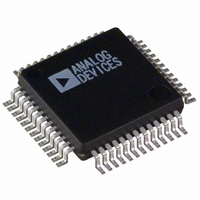ADUC834BSZ Analog Devices Inc, ADUC834BSZ Datasheet - Page 63

ADUC834BSZ
Manufacturer Part Number
ADUC834BSZ
Description
IC ADC DUAL16/24BIT W/MCU 52MQFP
Manufacturer
Analog Devices Inc
Series
MicroConverter® ADuC8xxr
Specifications of ADUC834BSZ
Core Size
8-Bit
Program Memory Size
62KB (62K x 8)
Oscillator Type
Internal
Core Processor
8052
Speed
12.58MHz
Connectivity
EBI/EMI, I²C, SPI, UART/USART
Peripherals
POR, PSM, PWM, Temp Sensor, WDT
Number Of I /o
34
Program Memory Type
FLASH
Eeprom Size
4K x 8
Ram Size
2.25K x 8
Voltage - Supply (vcc/vdd)
2.7 V ~ 5.25 V
Data Converters
A/D 3x16b, 4x24b; D/A 1x12b
Operating Temperature
-40°C ~ 125°C
Package / Case
52-MQFP, 52-PQFP
Controller Family/series
(8052) ADUC
No. Of I/o's
26
Eeprom Memory Size
62KB
Ram Memory Size
2KB
Cpu Speed
12.58MHz
Package
52MQFP
Device Core
8052
Family Name
ADuC8xx
Maximum Speed
12.58 MHz
Operating Supply Voltage
3.3|5 V
Data Bus Width
8 Bit
Number Of Programmable I/os
26
Interface Type
I2C/SPI/UART
On-chip Adc
4-chx16-bit|4-chx24-bit
On-chip Dac
1-chx12-bit
Number Of Timers
3
Lead Free Status / RoHS Status
Lead free / RoHS Compliant
Available stocks
Company
Part Number
Manufacturer
Quantity
Price
Company:
Part Number:
ADUC834BSZ
Manufacturer:
TOSHIBA
Quantity:
1 200
Company:
Part Number:
ADUC834BSZ
Manufacturer:
Analog Devices Inc
Quantity:
10 000
Part Number:
ADUC834BSZ
Manufacturer:
ADI/亚德诺
Quantity:
20 000
ADuC834 HARDWARE DESIGN CONSIDERATIONS
This section outlines some of the key hardware design consider-
ations that must be addressed when integrating the ADuC834
into any hardware system.
External Memory Interface
In addition to its internal program and data memories, the
ADuC834 can access up to 64 Kbytes of external program memory
(ROM/PROM/and so on) and up to 16 Mbytes of external data
memory (SRAM).
To select from which code space (internal or external program
memory) to begin executing code, tie the EA (external access)
pin high or low, respectively. When EA is high (pulled up to
V
internal 62 Kbytes Flash/EE code space. When EA is low (tied
to ground) user program execution will start at Address 0 in the
external code space. When executing from internal code space,
accesses to the program space above F7FFH (62 Kbytes) will be
read as NOP instructions.
Note that a second very important function of the EA pin is
described in the Single Pin Emulation Mode section.
External program memory (if used) must be connected to
the ADuC834 as illustrated in Figure 58. Sixteen I/O lines
(Ports 0 and 2) are dedicated to bus functions during external
program memory fetches. Port 0 (P0) serves as a multiplexed
address/databus. It emits the low byte of the program counter
(PCL) as an address, and then goes into a high impedance input
state awaiting the arrival of the code byte from the program
memory. During the time that the low byte of the program counter
is valid on P0, the signal ALE (Address Latch Enable) clocks
this byte into an external address latch. Meanwhile, Port 2 (P2)
emits the high byte of the program counter (PCH), and PSEN
strobes the EPROM and the code byte is read into the ADuC834.
Note that program memory addresses are always 16 bits wide,
even in cases where the actual amount of program memory used
is less than 64 Kbytes. External program execution sacrifices two
of the 8-bit ports (P0 and P2) to the function of addressing the
program memory. While executing from external program memory,
Ports 0 and 2 can be used simultaneously for read/write access
to external data memory, but not for general-purpose I/O.
REV. A
DD
), user program execution will start at Address 0 in the
Figure 58. External Program Memory Interface
ADuC834
PSEN
ALE
P0
P2
LATCH
OE
D0–D7
(INSTRUCTION)
A0–A7
A8–A15
EPROM
–63–
Though both external program memory and external data
memory are accessed using some of the same pins, the two are
completely independent of each other from a software point of
view. For example, the chip can read/write external data memory
while executing from external program memory.
Figure 59 shows a hardware configuration for accessing up to
64 Kbytes of external data memory. This interface is standard
to any 8051 compatible MCU.
If access to more than 64 Kbytes of RAM is desired, a feature
unique to the MicroConverter allows addressing up to 16 Mbytes
of external RAM simply by adding an additional latch as illus-
trated in Figure 60.
In either implementation, Port 0 (P0) serves as a multiplexed
address/databus. It emits the low byte of the data pointer (DPL)
as an address, which is latched by ALE prior to data being placed
on the bus by the ADuC834 (write operation) or the external
data memory (read operation). Port 2 (P2) provides the data
pointer page byte (DPP) to be latched by ALE, followed by the
data pointer high byte (DPH). If no latch is connected to P2,
DPP is ignored by the SRAM, and the 8051 standard of 64 Kbyte
external data memory access is maintained.
Detailed timing diagrams of external program and data memory
read and write access can be found in the Timing Specification
sections of this data sheet.
Figure 59. External Data Memory Interface
(64 Kbytes Address Space)
Figure 60. External Data Memory Interface
(16 Mbytes Address Space)
ADuC834
ADuC834
ALE
ALE
WR
WR
RD
RD
P2
P2
P0
P0
LATCH
LATCH
LATCH
A0–A7
D0–D7
(DATA)
A0–A7
A8–A15
A16–A23
OE
WE
D0–D7
(DATA)
A8–A15
OE
WE
ADuC834
SRAM
SRAM



















